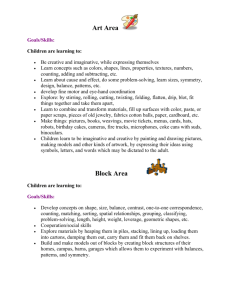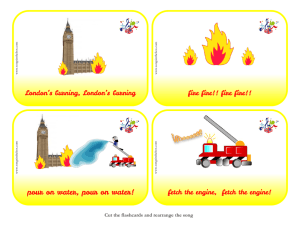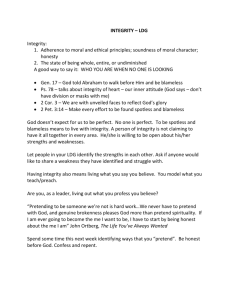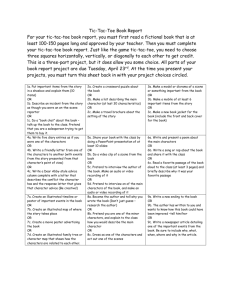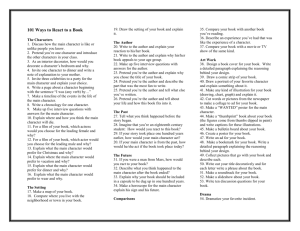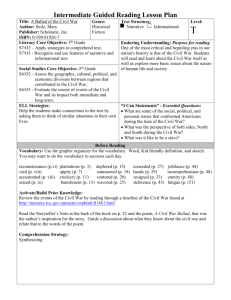Year 1 February Theme: Safety! This document and all Creatively
advertisement
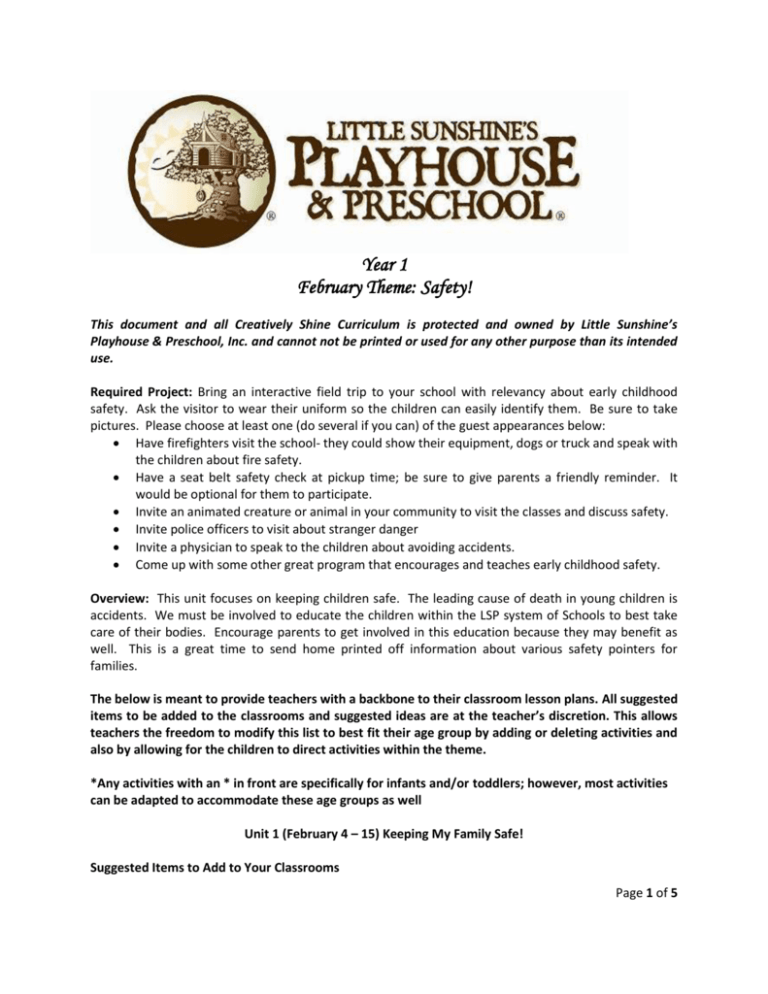
Year 1 February Theme: Safety! This document and all Creatively Shine Curriculum is protected and owned by Little Sunshine’s Playhouse & Preschool, Inc. and cannot not be printed or used for any other purpose than its intended use. Required Project: Bring an interactive field trip to your school with relevancy about early childhood safety. Ask the visitor to wear their uniform so the children can easily identify them. Be sure to take pictures. Please choose at least one (do several if you can) of the guest appearances below: Have firefighters visit the school- they could show their equipment, dogs or truck and speak with the children about fire safety. Have a seat belt safety check at pickup time; be sure to give parents a friendly reminder. It would be optional for them to participate. Invite an animated creature or animal in your community to visit the classes and discuss safety. Invite police officers to visit about stranger danger Invite a physician to speak to the children about avoiding accidents. Come up with some other great program that encourages and teaches early childhood safety. Overview: This unit focuses on keeping children safe. The leading cause of death in young children is accidents. We must be involved to educate the children within the LSP system of Schools to best take care of their bodies. Encourage parents to get involved in this education because they may benefit as well. This is a great time to send home printed off information about various safety pointers for families. The below is meant to provide teachers with a backbone to their classroom lesson plans. All suggested items to be added to the classrooms and suggested ideas are at the teacher’s discretion. This allows teachers the freedom to modify this list to best fit their age group by adding or deleting activities and also by allowing for the children to direct activities within the theme. *Any activities with an * in front are specifically for infants and/or toddlers; however, most activities can be adapted to accommodate these age groups as well Unit 1 (February 4 – 15) Keeping My Family Safe! Suggested Items to Add to Your Classrooms Page 1 of 5 Stop Signs First aid items Car seats Electric outlet plugs Safety goggles Reflectors Safety cones Suggested Ideas for Focus on the "Whole Child" Social/Emotional Car seat game – who can buckle up first (practice counting as a class) support and encourage each other rather than being overly competitive Learn about stranger danger (literature, video, guest speaker). Quiz the class on simple stranger danger questions throughout the week to reinforce. Bring in a demo empty box of matches, a non-operable lighter and other “no touch” items. Identify in small groups and encourage discussions about the items. Make up a song or cheer about safety Play a “hot” or “not” game using real items or flashcards. This is a good time to introduce or enforce the term “opposites.” Invite parents to bring their child’s life jacket or bicycle helmet to school for the day. Let children take turns wearing the jackets and helmets and go on wonderful pretend adventures (great activity for the playground). Physical (fine and gross motor) Practice writing and identifying the symbol for “not allowed” (circle with a diagonal line through an item enclosed in the circle). Make up your own and have some fun with it…ex: no smoking allowed, no dogs allowed, etc. Make a band aid art project or picture Work on patterning at circle time. Use different shaped band aids and ask children what comes next. Allow them to follow-up with a patterning creative project. Make a pretend road in your classroom with stop signs. Teach children to look both ways and hold an adults hand while crossing the street. Wear safety goggles and practice hammering Place tiny reflectors on a paper bicycle that the children cut out or decorate. Demonstrate what a real reflector does within the classroom. Make a pretend cast for each child’s arm (pretend to be hurt for one whole day and evening). Take casts back off the children at circle time the next day. Parents will enjoy being a part of the experience. *Create obstacle course out of safety cones for the children to walk and crawl around Cognitive Show children a first aid kit containing band aids, cotton balls and gauze. Count the items then place in a bag. Have blindfolded children reach in the bag and retrieve an item to identify. Discuss how some dangerous medication looks like candy. Teach children never to eat something that looks like candy until they ask an adult. Page 2 of 5 Have children make a list of what they can do if they are lost from their parents at the grocery store or other public venue. Make a chart and list all their great ideas giving them credit by adding their name. Then ask them what not to do….chart again. Post this chart for parents to read. They enjoy reading dictation in the child’s actual words. Count the electrical outlets in the classroom, hallway, and lobby. Teach electrical safety. With older children work on simple addition (2 outlets in the hall plus 2 in the classroom equals 4 total). Use this opportunity to discuss and demonstrate electrical safety plugs. Discuss water safety – pools, lake, bathtub, etc. Pretend to go swimming across the ocean wearing a pretend life jacket (or handmade life jacket); encountering humpback whales, sharks, and large waves. *What’s in the medical bag – fill a bag with cotton balls, gauze, band-aids, thermometer, etc. and have the children identify the items as you pull them out of the bag Language/Communication Discuss crossing guards at school. Let children take turns being the crossing guard and wearing the orange jacket. Encourage discussions between the children regarding safety procedures the crossing guard would follow. Teach children to write or spell the word SAFE. Practice through song, chant, or repetitive action. Hide the letters in the word SAFE around the classroom and have children find them and arrange correctly. Have fun scavenger hunts to search for the letters. Play “I Spy” something dangerous. Teach the children to identify things they need to avoid. Learn the words hot, danger, and safe in sign language and second language. It would be great to add these into the cheer or song in order to increase retention. Have children demonstrate for parents. Workbook Curriculum Workbook curriculum should be carried out daily in each classroom with (children over the age of 12 months) for 10-20 minutes, depending on age. At this time we are not mandating what brand or type of workbook. Workbooks should teach general cognitive principals for the child’s age (colors, shapes, tracing, recognition, memorization, numbers, and alphabet). The activity should be in paper form and available for parents to review at least weekly. This addition to our curriculum is a supplement needed to meet the expectations of families and further prepare children for Kindergarten. Workbook curriculum is not considered a creative art experience; it is merely a supplement to encourage cognitive growth. Unit 2 (February 16th-27th) My Friend the Fireman Suggested Items to Add to Your Classrooms Fireman hats and clothes Fire trucks Hose Fire hydrants Dalmatian Dogs and puppies Bonus idea- Set up a pretend fire truck in a common space in your building Page 3 of 5 Suggested Ideas for Focus on the "Whole Child" Social/Emotional Play active games to reinforce the concept that children should not be afraid of firemen. Dress someone up in a pretend suit, and pretend to rescue children out of the building to the nearest exit. Show children to identify exit signs. Have an additional fire drill this week, even if you were not scheduling it. Practice over and over until the kids are comfortable. Play pin the tail on the Dalmatian puppy. Encourage a creative project to make a Dalmatian puppy (color the spots, cut out the puppy, make a collar, give the puppy commands to save a baby in a burning building). Pretend to be a fireman who lives at the fire station. They cook meals together and live like a family. Let children share their experiences with a real fireman to the class. Make a Fireman’s treat for snack Physical (fine and gross motor) Hide the children’s Dalmatian puppies around the classroom each morning. Once all children arrive have a puppy hunt. Make a fireman’s hat for each child. Assign badge numbers and work on number recognition. Color and cut out a picture of a fireman on cardstock. Take photos of each child’s face and put on their fireman’s face. Turn off and on a real or pretend water hose and practice spraying out a pretend fire Practice stop, drop, and roll (many times for good exercise) Cognitive Measure a fire hose with a yard stick and a ruler Draw a dot to dot number picture (age appropriate) of a fire truck or other fire safety item Discuss smoke rising and practice crawling out of a pretend burning building Use pretend or real walkie talkies for the little firemen to chat Color or paint an image of fire and identify colors in a flame Language/Communication Read stories about real firemen Make a set of flash cards for each child with those words that you taught in a second language and/or sign. Send home with children to practice with parents. Make sure children know the words before you send the flashcards home. Watch a portion of a safety film or read a book about safety Use stuffed animals to act out a scary fire scene. Use this opportunity to drive the point home to the children not to hide from firemen if their home is on fire. Discuss as a class the good decisions and the bad decisions of the stuffed animals. Learn the words fireman, fire, help, etc. in sign language and second language Workbook Curriculum Workbook curriculum should be carried out daily in each classroom with (children over the age of 12 months) for 10-20 minutes, depending on age. At this time we are not mandating what brand or type of workbook. Workbooks should teach general cognitive principals for the child’s age (colors, shapes, tracing, recognition, memorization, numbers, and alphabet). The activity Page 4 of 5 should be in paper form and available for parents to review at least weekly. This addition to our curriculum is a supplement needed to meet the expectations of families and further prepare children for Kindergarten. Workbook curriculum is not considered a creative art experience; it is merely a supplement to encourage cognitive growth. Page 5 of 5
